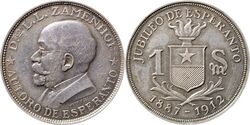| 1 spesmilo | |
|---|---|

| |
| General information | |
| Movement | |
| Value | |
| Years |
1912 |
| Measurements and composition | |
| Mass |
12.6 g |
| Diameter |
30 mm |
| Thickness |
2 mm |
| Composition |
silver |
| Appearance | |
| Shape |
round |
| Alignment |
medallic |
| Edge |
reeded |
| Obverse | |
| Reverse |
Coat of arms, value |
| v · d · e | |
The 1 spesmilo coin is a former commemorative coin of the Esperanto movement. It, along with 2 and 50 spesmilo pieces of similar design, was issued in 1912 in commemoration of the 25th anniversary of Unua Libro, the first publication describing Esperanto. The piece was authorized by the Ĉekbanko Esperantista or Swiss Esperantists and struck by the Swiss watch case and medal-making firm Holy Frères.
The piece was initially intended to be sold as a collector's item at the 9th World Esperanto Congress in Bern in 1913. However, although not designed for general use, the coin saw limited circulation before 1918. It was reportedly accepted by a handful of British and Swiss banks, including the Ĉekbanko Esperantista.
The coin is composed of .9167 fine silver (91.67 percent silver, 8.33 percent copper) and measures 12.6 grams in mass, 30 millimeters in diameter, and 2 millimeters in thickness. It has medallic alignment and a reeded edge, and is round in shape. Both of its rims are raised and decorated with a dentilated border.
A left-facing bust of L. L. Zamenhof (1859–1917), the creator of Esperanto, is displayed in the middle of the coin's obverse. In the depiction, Zamenhof is portrayed sporting a mustache and goatee and wearing a jacket and collared shirt and his signature glasses. Engraved in small print near the bust truncation below is the inscription "HOLY·fres", which is abbreviated for the name of the manufacturer, "Holy Frères". The Esperanto legend "D.RO L.L. ZAMENHOF", which is shortened for Doctoro L.L. Zamenhof and translates as "Doctor L.L. Zamenhof", is written clockwise along the periphery above Zamenhof's likeness. Printed in the opposite direction at the periphery below is the caption "AUTORO DE ESPERANTO", which translates as "Author of Esperanto". The two inscriptions are separated from one another by two five-pointed stars, one at either side of the obverse.
A rendition of an unofficial Esperantist coat of arms is illustrated in the center of the reverse. This image consists of a two-fold escutcheon featuring the green star, a symbol of Esperanto, in the upper field and a dark color in the lower field. Two crossed branches appear below the escutcheon in the arms, and a flame is displayed above. The face value "1" is engraved horizontally in the middle of the reverse, the numeral and spesmilo sign separated onto separate sides the arms. Printed clockwise along the periphery above is the Esperanto legend "JUBILEO DE ESPERANTO", which translates as "Jubilee of Esperanto". Inscribed in the opposite direction at the rim below are the dates "1887 - 1912", the first representing the year Unua Libro was published and the second signifying the date of the book's 25th anniversary.
The exact mintage of the piece is currently unknown, but no more than four examples are believed to exist.
References
- Numismatic Guaranty Corporation – Esperanto - Spesmilo, X# 1 (1912)
- Numista – 1 Spesmilo (1912) (English) (French)
- Chiefa Coins – Esperanto (Universala Ligo)
- Esperanto Numismatika Asocio – "Esperanta Numismatiko" (2015) (Esperanto)
Esperantismo kaj mono on the Esperanto Wikipedia
| Spesmilo | |
|---|---|
| Coins | 1₷ • 2₷ • 50₷ |
| Banknotes | ½₷ • 1₷ • 2₷ • 5₷ • 10₷ |
| Miscellaneous | Ĉekbanko esperantista • Holy Frères • Universal Spesmilo Bank |
